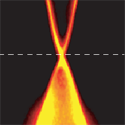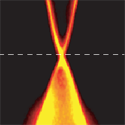A more perfect Dirac cone
Topological insulators, a class of materials whose surfaces are metallic while insulating in bulk, have taken the condensed matter physics world by storm. First predicted in 2005, such properties were later seen in a variety of bismuth alloys. The conducting surface states are marked in particular by a Fermi surface (the plot of carrier energy in momentum-space coordinates) shaped like a cone. These so-called Dirac cones are characteristic of the unusual surface transport and are also seen in graphene. Much of the interest in these materials stems from the possibility of using their topological robustness in quantum information processing.
The Dirac cone, however, is an idealization—most real materials show warping of the cone surface as the carrier mobility is reduced by the bulk states. In a paper in Physical Review Letters, researchers in a large international collaboration from institutions in Japan, Russia, and Spain report their studies of a new topological insulator, thallium bismuth selenide. Such compounds have been proposed as potentially having more ideal undistorted Dirac cone behavior. Using angle-resolved photoemission spectroscopy, the authors show that the surface states in thallium bismuth selenide have an almost perfect Dirac cone, well isolated from bulk continuum states. Future studies should tell whether this material has the high mobility and spin polarization lifetimes necessary to make progress in quantum computing. – David Voss





